In the ever-evolving landscape of digital marketing, email remains a cornerstone of customer engagement. Two platforms that have gained significant traction in recent years are Mailchimp and Substack. While both serve the purpose of email communication, they cater to distinctly different needs and audiences. This comprehensive comparison delves into the intricacies of Mailchimp and Substack, exploring their features, strengths, and limitations to help you determine which platform aligns best with your email marketing strategies.
Key Facts
- Mailchimp offers comprehensive email marketing tools suitable for businesses of all sizes.
- Substack focuses on content monetization for writers and creators.
- Both platforms prioritize ease of use but differ significantly in customization options and advanced features.
Comparing Giants: Mailchimp’s Versatility vs Substack’s Simplicity
Mailchimp and Substack represent two distinct approaches to email marketing. Mailchimp stands out as a versatile, feature-rich platform that caters to a wide range of marketing needs. Its intuitive interface, coupled with advanced automation and integration capabilities, makes it a go-to choice for businesses seeking comprehensive email marketing solutions.
On the other hand, Substack has carved out a niche for itself by focusing on simplicity and content monetization. It appeals to writers and content creators who prioritize straightforward newsletter creation and distribution. As noted by EmailToolTester.com, “Substack’s interface is highly intuitive, making it easy for beginners to start writing newsletters.”
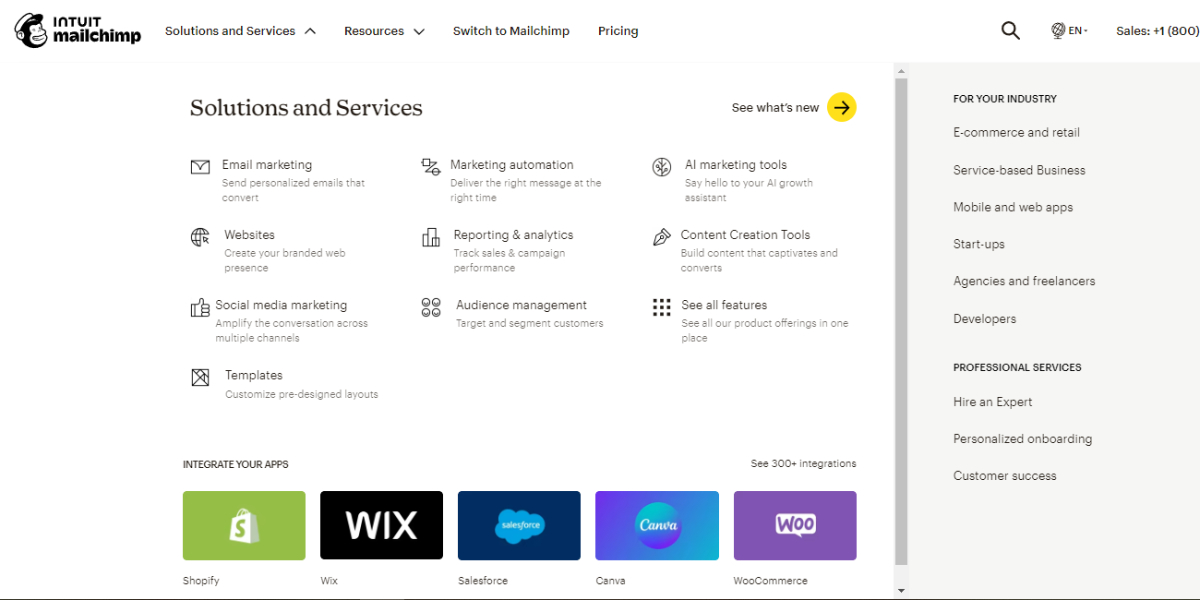
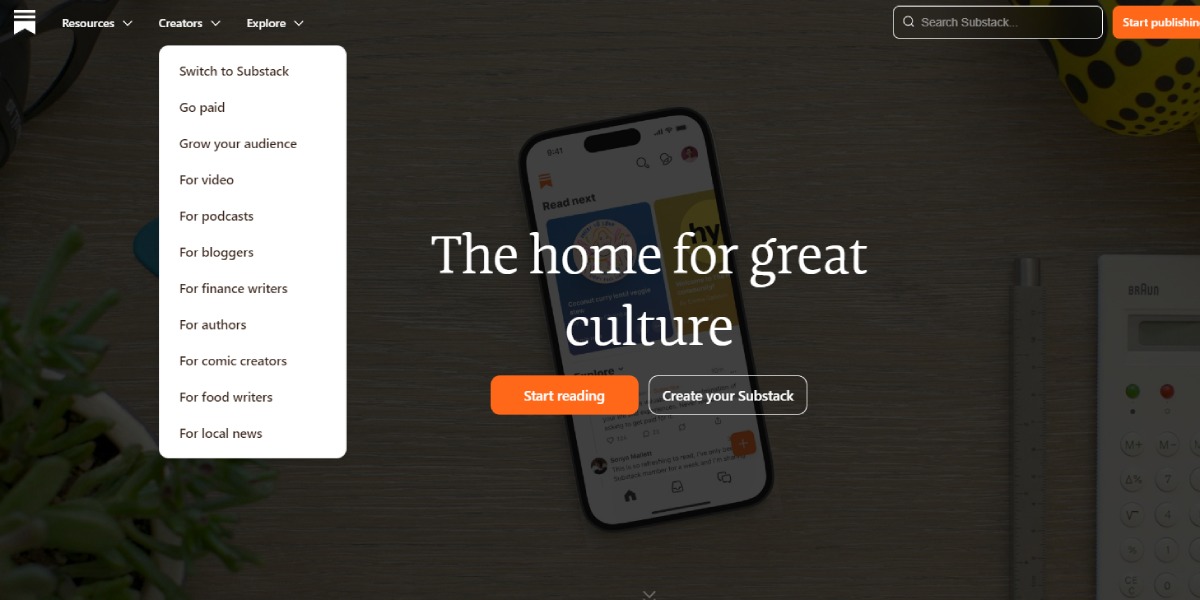
Hidden Gem: Utilize Substack’s SEO Advantages
One of Substack’s significant advantages over Mailchimp is its SEO-friendly nature. Unlike Mailchimp, Substack content is indexed by search engines, making your newsletters discoverable online. This can drive organic traffic to your content, increasing both free and paid subscribers over time. By leveraging this feature, content creators can enhance their visibility and reach a broader audience without solely relying on their email lists.
User Interface and Ease of Use
Mailchimp is renowned for its user-friendly interface, featuring a visual drag-and-drop editor that simplifies email creation. This accessibility makes it suitable for users of all skill levels, from beginners to experienced marketers. The platform’s AI-assisted builder further enhances the user experience, offering intelligent suggestions for content and design.
Substack, in contrast, boasts a minimalistic design that prioritizes content creation over complex features. Its uncluttered interface and straightforward setup process make it particularly appealing to writers and content creators who want to focus on their message rather than navigating intricate marketing tools. The platform’s simplicity extends to its onboarding process, allowing users to start writing and publishing newsletters with minimal steps.
Email Templates and Customization
Mailchimp offers a vast library of customizable templates, catering to diverse design preferences and industry needs. The AI-assisted builder complements these templates, providing intelligent suggestions for layout and content. This level of customization allows businesses to maintain brand consistency across their communications while also experimenting with different designs to optimize engagement.
Substack, focusing more on content than design, provides basic templates with limited customization options. This approach aligns with its target audience of writers and content creators who prioritize the written word over visual complexity. While this may limit branding opportunities, it ensures that the content remains the focal point of each newsletter, which can be advantageous for certain types of creators.
Hidden Gem: Create Tiers of Subscriptions on Substack
Substack allows creators to implement different subscription tiers—free, paid, and premium—to cater to diverse audience needs. This strategy can maximize revenue by offering exclusive content at various price points. By creating tiered subscriptions, content creators can attract a broader range of subscribers, providing value at multiple levels and encouraging free subscribers to upgrade to paid plans for additional benefits.
Advanced Features and Analytics
Mailchimp’s strength lies in its robust feature set, offering advanced segmentation, A/B testing, and detailed analytics. These tools allow marketers to fine-tune their campaigns for optimal performance. The platform provides real-time campaign tracking, enabling marketers to monitor engagement as it happens and make timely adjustments. Additionally, Mailchimp offers tools for tracking return on investment and measuring the effectiveness of marketing strategies, providing valuable insights for businesses looking to maximize their email marketing ROI.
Hidden Gem: Leverage Mailchimp’s Advanced Segmentation
Mailchimp’s extensive segmentation tools allow users to create highly targeted campaigns by segmenting their audience based on detailed criteria such as purchase history, engagement level, or demographic information. This level of segmentation can significantly improve open and click-through rates by ensuring that the right message reaches the right audience. Advanced segmentation enables more personalized and relevant communication, enhancing overall campaign effectiveness.
Hidden Gem: Use Mailchimp’s Automation Templates
Mailchimp offers pre-built automation templates that streamline email marketing efforts. These templates help users quickly set up welcome emails, follow-ups, and promotional campaigns without starting from scratch. By utilizing these automation templates, marketers can save time and ensure consistency in their communication, allowing them to focus on crafting engaging content rather than managing technical aspects of email campaigns.
Hidden Gem: Experiment with A/B Testing in Mailchimp
Regularly conducting A/B tests on subject lines, send times, and content formats within Mailchimp can help identify what resonates best with your audience. By experimenting with different variables, marketers can optimize future campaigns for better performance. A/B testing enables data-driven decision-making, ensuring that email marketing strategies are continuously refined and improved based on real user behavior and preferences.
Integrations and Scalability
Mailchimp supports a wide array of third-party integrations, including e-commerce platforms like Shopify and WooCommerce. This extensive integration capability makes it suitable for businesses of all sizes, from small startups to large enterprises. The platform’s scalability is further enhanced by its ability to handle complex marketing strategies and large subscriber lists, albeit with potential pricing complexities as subscriber counts increase.
Substack, while excellent for individual creators, offers limited integration options compared to Mailchimp. It focuses mainly on basic functionalities like payment processing and analytics. This approach aligns with its target audience of individual writers and small to mid-sized newsletters but may lack the features necessary for large enterprises or complex marketing strategies. The platform’s scalability is primarily geared towards growing a dedicated subscriber base rather than expanding marketing capabilities.
Pricing Models: Flexibility vs. Simplicity
Mailchimp’s pricing structure is described as potentially complex. According to DirectIQ, “Pricing can become more intricate as subscriber counts increase, potentially leading to unexpected costs.” This suggests that while Mailchimp offers flexibility, users may need to be cautious about cost increases as their subscriber base grows.
Substack, on the other hand, has a simpler pricing model. As stated by Email Crush, “Substack is free to use unless monetizing content, in which case it takes a 10% cut of paid subscriptions.” This straightforward approach aligns with Substack’s focus on content creators and writers. Additionally, Substack “charges a fee for custom domain setup, limiting free customization options” (Email Crush). This indicates that while the basic service is free, there are some additional costs for certain features.
The information provided does not include specific pricing tiers or exact costs for either platform, so a more detailed comparison of pricing structures is not possible based solely on the given input.
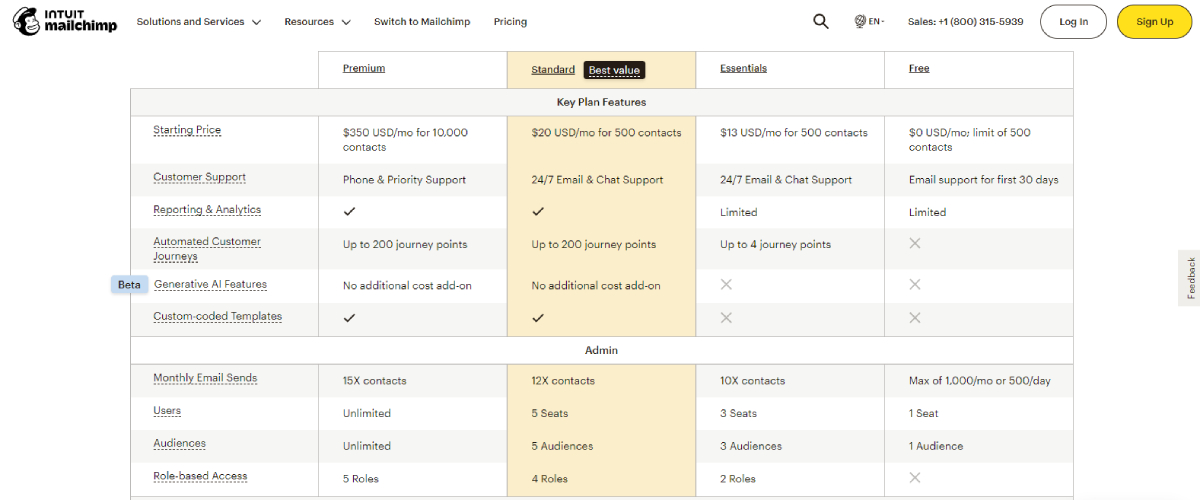
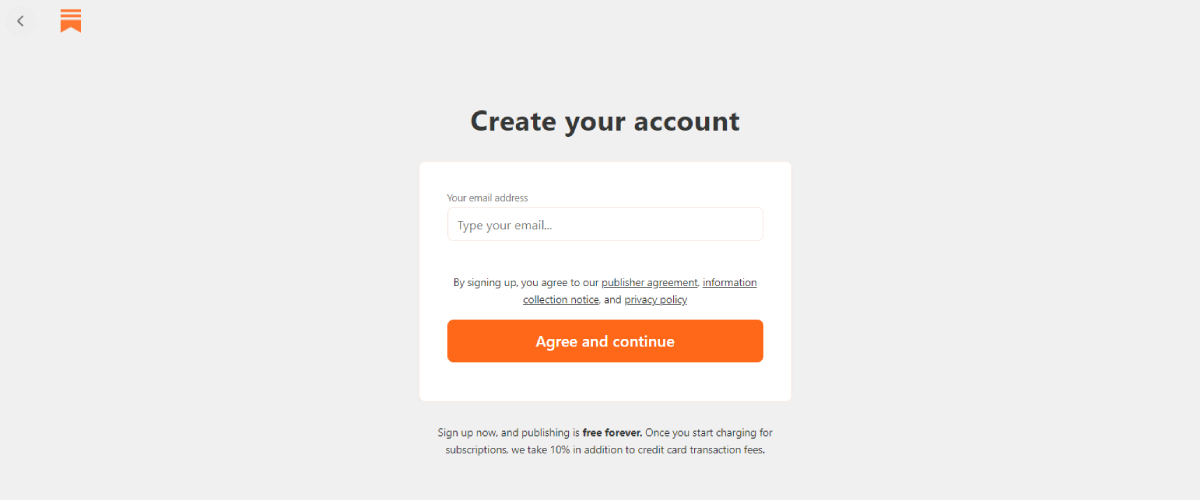
Innovative Solutions by Prism Reach
While Mailchimp and Substack dominate the email marketing landscape, innovative solutions like Prism Reach are emerging to address the growing demand for personalized, AI-driven email marketing. Prism Reach stands out by offering deep personalization through sophisticated AI algorithms, transforming how publishers and content creators engage with their audiences.
Company and Product Overview
Prism Reach’s core functionality revolves around its proprietary AI technology, which clusters website content and social media posts into relevant categories. This AI uses a variety of data points to create detailed user avatars, enabling personalized newsletter content that incorporates factors such as location, engagement history, and predicted interests. The system’s ability to analyze vast amounts of data allows for highly targeted marketing strategies.
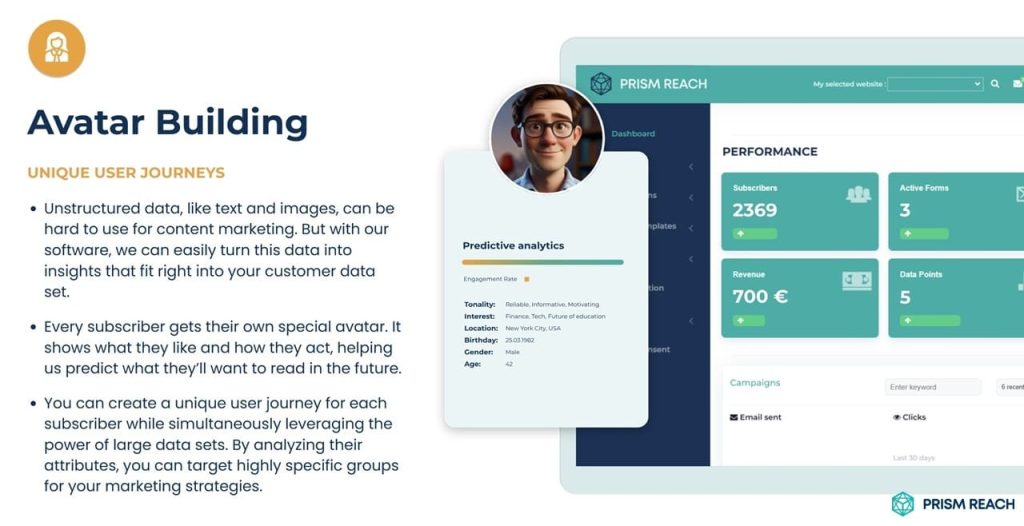
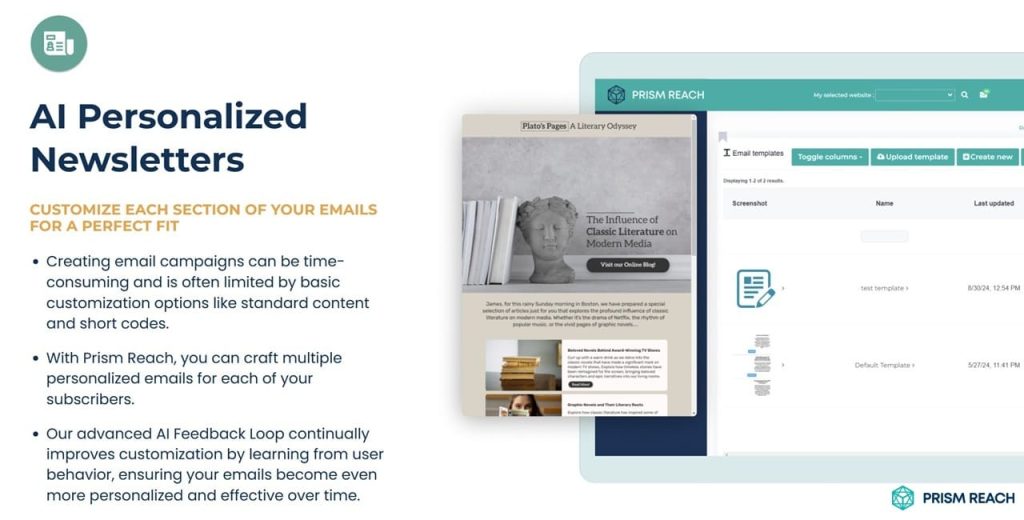

Target Audience
The primary users of Prism Reach are publishers across various platforms, including international media outlets, blogs, and forums. The company has also set its sights on expanding into the eCommerce sector, aiming to leverage its technology to enhance digital marketing efforts in this rapidly growing area.
Key Features
- AI-Powered Personalization:
- Content Clustering: Utilizes both open and proprietary AI models to categorize content effectively.
- User Avatars: Enriches user data for creating highly personalized profiles.
- Personalized Introductions: Generates custom introduction paragraphs for each subscriber using advanced data analytics.
- Optimal Sending Times: Uses predictive analytics to determine the best times to send newsletters, maximizing subscriber engagement.
- Seamless Setup and Integration:
- Quick Setup: The platform can be integrated within 10 minutes, making it user-friendly.
- One-Click Uploads: Facilitates easy migration of existing subscriber lists.
- AI-Enhanced Sign-Up Forms: Designed to increase sign-up rates through AI-generated content tailored to the user’s context and improve GDPR compliance.
- Dynamic Content Selection: The AI determines the most relevant content for each subscriber, enhancing the personalization of each newsletter.
- Advertising Network and Swap Network:
- Provides a platform for targeted advertising similar to major online ad networks, allowing for precise ad placement based on subscriber data.
- Facilitates mutual promotion among publishers, broadening content reach and enhancing subscriber engagement.
- Advanced AI Features: Includes anti-spam checks and a focus on high deliverability, crucial for maintaining engagement levels and avoiding spam filters.
Benefits of Prism Reach
- AI-Powered Personalization: Enhances engagement by tailoring content to subscriber preferences, resulting in up to 40% higher engagement rates.
- Advanced Segmentation: Allows highly targeted campaigns, improving open and click-through rates through detailed audience segmentation.
- Seamless Integration: Easily integrates with existing platforms like Mailchimp and Substack, streamlining marketing efforts and enabling a cohesive email marketing strategy.
Hidden Gem: Cross-Promotion Between Platforms
If you’re using both Mailchimp and Substack, cross-promote your Substack newsletter through Mailchimp emails. This strategy can help you transition existing subscribers to a more monetized platform while utilizing Mailchimp’s robust email capabilities. By promoting Substack within your Mailchimp campaigns, you can leverage the strengths of both platforms to maximize your reach and revenue potential.
User Journey
The typical user journey with Prism Reach involves a streamlined process where subscribers sign up through a customized form, select their interests, and then receive personalized newsletters that cater specifically to their preferences. This journey not only enhances user satisfaction but also boosts the likelihood of long-term subscriber retention.
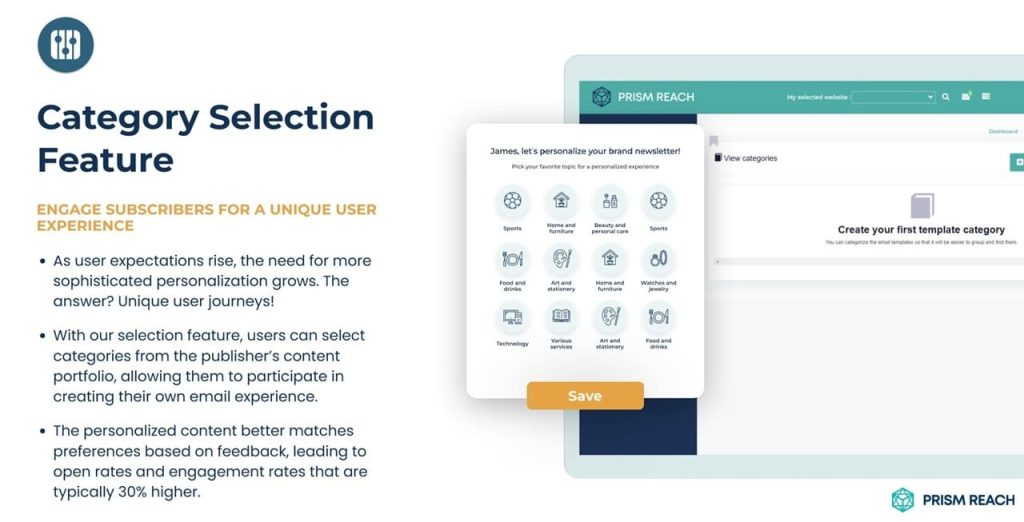
Compliance and Data Privacy
Prism Reach emphasizes GDPR compliance and hosts data within Europe, adhering to the highest standards of data protection. This focus on privacy is crucial for building trust with users and complying with international regulations.
Future Prospects
Looking ahead, Prism Reach aims to expand its technology into the eCommerce sector and explore new ways to leverage AI for broader marketing applications. The company is committed to the continuous improvement of its AI algorithms, ensuring that its solutions remain at the cutting edge of technology and marketing innovation.
Upgrade Your Email Marketing with AI Personalization!
Conclusion
In the Mailchimp vs Substack debate, the choice ultimately depends on your specific needs and goals. Mailchimp remains the go-to platform for businesses seeking comprehensive email marketing solutions with advanced features and extensive customization options. Substack, with its focus on simplicity and content monetization, is ideal for writers and content creators looking to build and monetize a dedicated subscriber base.
However, as the email marketing landscape evolves, innovative solutions like Prism Reach are pushing the boundaries of what’s possible with AI-driven personalization. Prism Reach offers deep personalization through sophisticated AI algorithms, transforming how publishers and content creators engage with their audiences. For those seeking cutting-edge technology to enhance their email marketing efforts, exploring newer platforms like Prism Reach may provide a competitive edge in an increasingly crowded digital space.